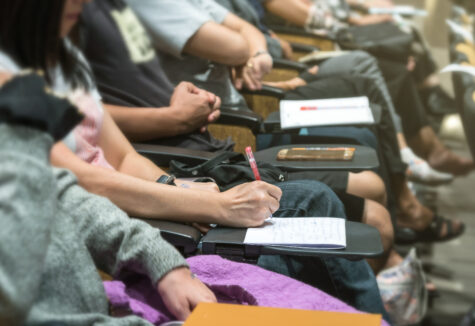- Blog
- > College Admissions
Why Are College Admission Rates So Low and Not Just at the Ivy League?
- Dr. Rachel Rubin
- | May 30, 2023

Every year, college admission rates seem to get lower. This might be expected at Ivy League schools like Harvard University, Yale University, and Brown University, whose admission rates have dropped to record lows in recent years. But the trend is widespread at selective schools. Last year, schools like Tufts University, Northeastern University, New York University (NYU), and Tulane University all saw their admission rates drop below 10%. Meanwhile, many additional colleges, from Boston University to University of Virginia (UVA) to the University of Miami, saw their admission rates drop below 20% (meaning fewer than 1 in 5 applicants are admitted).
This widespread change, affecting both public and private colleges and universities across the nation, raises the question: what is going on with college admission rates right now?
There are a few answers, all of which are important to understand if you want to approach the college admissions landscape knowledgeably and strategically. Admission rates can be highly variable year to year, but the overall trend points toward them becoming lower and lower, which has important consequences for current and future college applicants.
Colleges are Receiving More Applications Than Ever
At highly selective schools, particularly those ranked below the Ivy League, the number of applications has risen continuously over the last decade. Northeastern University, for instance, received more than 90,000 applications last year! Given that many colleges are not increasing their class sizes, or are doing so in a very limited capacity, this explosion in applications inevitably means that acceptance rates will drop, sometimes precipitously.
Note, however, that this doesn’t mean that more students are applying to college; indeed, the number of discrete applicants has actually fallen in recent years. Rather, as college admissions becomes more competitive and unpredictable, most students are submitting more applications than they might have in the past, likely in hopes that one of those applications will beat the odds. Further, structural changes like the ongoing elimination of standardized testing requirements and rampant grade inflation have also contributed to students submitting more and more applications.
The upshot is a vicious cycle: students submit more and more applications, colleges reject more and more students, the admissions process becomes more and more competitive, and students submit even more applications to try to beat the uncertainty.
Yield Protection: The Most Important College Admissions Trend to Understand
Another major factor in declining admission rates is that colleges are getting better at predicting which of their tens of thousands of applicants will actually attend if admitted. This statistic (the percentage of admitted students who ultimately matriculate) is commonly known as yield, and it is arguably the statistic that colleges care about most. The more certain they can be that a student they admit will attend, the fewer students they have to admit overall, and the lower their admission rate will be, further enhancing their selectivity. The more selective a school is, the better it will look in college rankings, such as U.S. News and World Report.
Obviously, because many college applicants gain admission at multiple colleges, colleges need to admit more students than they technically have room for in their class, because they know some people they admit will not matriculate. Colleges don’t like this uncertainty and have developed increasingly sophisticated methods of “yield protection”—attempting to admit students who they think genuinely might attend. By driving up their yield, they can also drive down their overall admission rate, because they don’t need to overcorrect so much.
How do colleges protect their yield? Some factors are beyond your control. For instance, if no one from your high school has matriculated at a college recently, you can bet that your application will be flagged. And if colleges sense they might be your safety school, they may turn your application away even if you do everything right. But yield is also why colleges take demonstrated interest very seriously (if the school tracks demonstrated interest); if you don’t visit, don’t engage with them, don’t follow up after applying, and so forth, they will know you’re not interested and may reject you even if you are qualified.
In the era of big data, college admissions offices have increasingly smart and sophisticated ways to predict their yield. As they get better at identifying genuinely interested candidates, they will need to admit fewer students, and admission rates will continue to fall.
More Active Waitlists
Finally, just as colleges have tried to maximize their yield up front, they have also made increasing use of waitlists compared to years past. As part of their efforts to reduce uncertainty and admit only those students they genuinely think will attend, selective colleges and Ivy League schools have waitlisted more and more qualified applicants. This means they haven’t outright rejected those students yet, but instead are waiting to see how many students matriculate and how many spots remain.
The upshot for colleges is, if a student they waitlist gets into a school they prefer more, they won’t ask to stay on the waitlist, meaning colleges don’t need to take a chance on admitting them. And if they do want to stay on the waitlist, admissions officers get another chance to evaluate their enthusiasm for potentially attending, again with an eye toward their yield. Then, if they have room or are impressed by the additional materials a student has submitted, colleges can admit them with much less uncertainty.
For these reasons, selective colleges and Ivy League schools have been making more active use of their waitlists in recent years. This can be frustrating for students, many of whom are still uncertain of their future at their top choice schools well into May, but it has also meant that colleges are drawing from waitlists more than ever, keeping students’ hopes alive.
What Do Low College Admission Rates Mean for You?
Right now, college admissions rates are caught in a feedback loop. Low admission rates and uncertainty about who gets in where, and why, has caused students to submit more and more applications, which in turn fuels the same uncertainty and unpredictability that spurred them to submit those applications in the first place. None of those practices seem poised to stop, so it’s very likely that more and more colleges will see their admission rates continue to plummet.
So, what can you do? Although many of these changes are beyond the control of any individual or school, a college applicant can still make smart choices when deciding where to apply. They can also use Early Decision strategically, demonstrate interest effectively at all the colleges to which they apply, and present themselves as impactfully as possible in their application materials.
If you want to discuss any of these college admission rate changes and how they might affect your college admissions process or if you’d like to understand better how to position yourself effectively in this increasingly competitive landscape, we recommend that you schedule an initial consultation with us!


